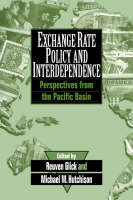
Exchange Rate Policy and Interdependence
Cambridge University Press (Verlag)
978-0-521-04123-2 (ISBN)
Why countries choose different exchange rate arrangements and how these arrangements affect domestic monetary policy control and macroeconomic stability are questions of substantial interest to policy makers and researchers alike. The countries of the Pacific Basin region offer a wide variety of examples for the comparative study of the implications of different exchange rate arrangements. The essays in this volume examine the degree of financial interdependence and the conduct of exchange rate and monetary policy among Pacific Basin countries. The essays address four broad issues: one, the degree of regional financial market integration in the Pacific Basin, two, the implications of choosing different exchange rate regimes for domestic macroeconomic stability, three, the effect of exchange rate intervention policy on the conduct of domestic monetary policy, and four, the prospects for a yen currency bloc. Some of the essays focus on the national experience of specific countries in the Pacific Basin; others adopt a cross-country comparison approach.
List of contributors; Preface; 1. Overview Reuven Glick and Michael M. Hutchison; Part I. International Financial Market Integration: 2. Financial links around the Pacific Rim: 1982–92 Menzie D. Chinn and Jeffrey A. Frankel; 3. Relative returns on equities in Pacific Basin countries Charles Engel and John H. Rogers; 4. Exchange rate policy, international capital mobility and monetary policy instruments Michael P. Dooley and Donald J. Mathieson; Part II. Choice of Exchange Rate Regimes: 5. Exchange rate management: a partial review Stephen J. Turnovsky; 6. Exchange rate policy and insulation from external shocks: the cases of Korea and Taiwan, 1970–90 Ramon Moreno; 7. Trade price shocks and insulation: Australia's experience with floating rates John Pitchford; 8. The role of the exchange rate in New Zealand monetary policy Arthur Grimes and Jason Wong; 9. Officially floating, implicitly targeted exchange rates: examples from the Pacific Basin Helen Popper and Julia Lowell; Part III. Intervention and Sterilization Policies: 10. Monetary policy, intervention and exchange rates in Japan Reuven Glick and Michael M. Hutchison; 11. The signaling effect of foreign exchange intervention: the case of Japan Tsutomu Watanabe; 12. Sterilization of the monetary effects of current account surpluses and its consequences: Korea, 1986–90 Sung Y. Kwack; Part IV. Prospects for a Yen Bloc: 13. On the possibility of a yen bloc Takatoshi Ito; 14. Economic fundamentals and a yen currency area for Asian Pacific Rim countries Michael Melvin, Michael Ormiston and Bettina Peiers; Index.
| Erscheint lt. Verlag | 18.10.2007 |
|---|---|
| Zusatzinfo | 58 Tables, unspecified; 34 Line drawings, unspecified |
| Verlagsort | Cambridge |
| Sprache | englisch |
| Maße | 150 x 227 mm |
| Gewicht | 581 g |
| Themenwelt | Wirtschaft ► Volkswirtschaftslehre ► Finanzwissenschaft |
| Wirtschaft ► Volkswirtschaftslehre ► Makroökonomie | |
| ISBN-10 | 0-521-04123-6 / 0521041236 |
| ISBN-13 | 978-0-521-04123-2 / 9780521041232 |
| Zustand | Neuware |
| Haben Sie eine Frage zum Produkt? |
aus dem Bereich


